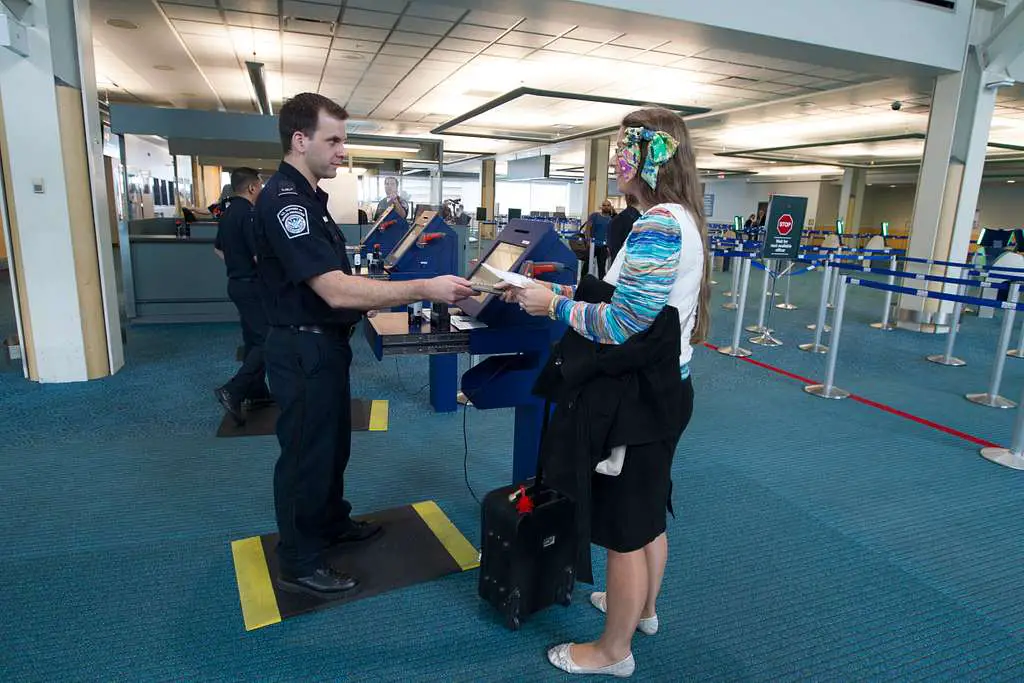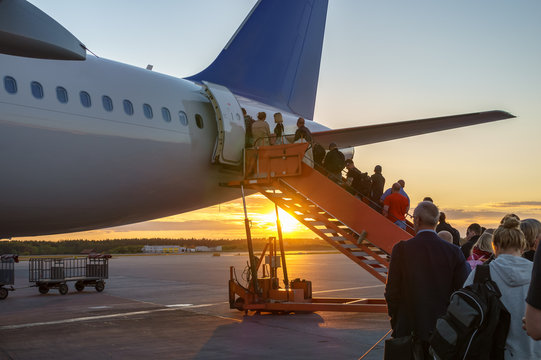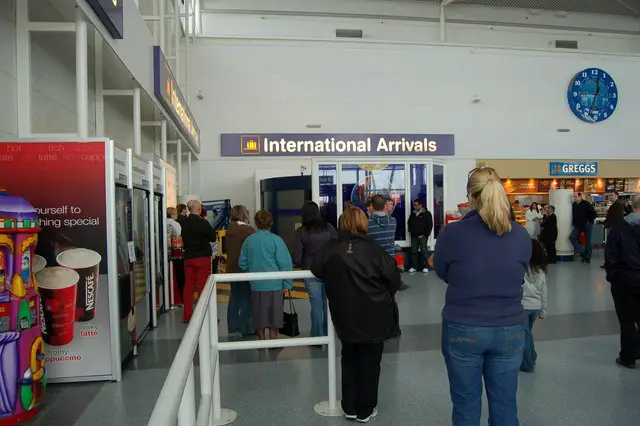The Procedure At Airport For Domestic Flight involves a series of structured steps designed to ensure a seamless and secure travel experience for passengers within the confines of a specific country.
From check-in to boarding, passengers navigate through various checkpoints and procedures, each serving a crucial role in the overall efficiency and safety of domestic air travel.
Understanding and adhering to these procedures is essential for passengers to facilitate a hassle-free journey, encompassing aspects such as security screenings, baggage handling, and document verification.
This systematic approach not only enhances the efficiency of airport operations but also contributes to the overall satisfaction and comfort of travelers embarking on domestic flights.
1. Check-In Process
Online Check-In
One pivotal aspect of the Procedure At Airport For Domestic Flight is the check-in process, where passengers can leverage the convenience of online check-in.
This digital prelude to the journey enables travelers to confirm their presence on the flight, select seats, and even print boarding passes from the comfort of their homes.
Online check-in not only expedites the overall airport experience but also provides passengers with the flexibility to choose their preferred seats well in advance, enhancing the efficiency of the boarding process.
Counter Check-In
For those who prefer a more traditional approach, counter check-in remains a viable option within the Procedure At Airport For Domestic Flight.
At the airport counters, airline staff assist passengers with the check-in process, accepting baggage and verifying travel documents.
Counter check-in ensures a personalized and thorough service, addressing any queries or concerns that passengers may have, thereby catering to a diverse range of preferences and travel needs.
2. Security Check

Document Verification
Integral to the Procedure At Airport For Domestic Flight is the meticulous document verification process. Security personnel rigorously examine passengers’ identification, boarding passes, and any other relevant travel documents to ensure compliance with aviation regulations.
This initial step is crucial for confirming the identity of travelers and ensuring that only authorized individuals proceed further into the secure areas of the airport.
Security Screening
As an imperative component of the Procedure At Airport For Domestic Flight, security screening is paramount for the safety of all passengers.
Through advanced screening technologies, including X-ray machines and metal detectors, security personnel thoroughly inspect carry-on items and individuals for any prohibited items or potential security threats.
This thorough yet efficient process not only safeguards the well-being of passengers but also upholds the overall integrity of domestic air travel.
3. Boarding Process
Gate Announcement
In the Procedure At Airport For Domestic Flight, the boarding process commences with gate announcements, signaling the beginning of the embarkation phase.
Passengers are informed about the designated gate for their flight, allowing them to proceed to the boarding area in a timely manner.
Clear and timely gate announcements are crucial in ensuring an organized and smooth boarding experience for all travelers.
Boarding Pass Verification
Upon reaching the boarding gate, passengers undergo a thorough boarding pass verification process. Airline staff meticulously check boarding passes to confirm passengers’ eligibility for boarding, ensuring that the right individuals are boarding the correct flight.
This step adds an extra layer of security and precision to the overall boarding procedure.
Security Screening
In certain instances, domestic flights may require an additional security screening at the boarding gate. This supplementary screening, if deemed necessary, ensures the continued safety of the flight and its passengers.
Passengers are subject to thorough checks to detect any potential security threats before boarding the aircraft.
4. Departure Lounge
Waiting Area
The departure lounge serves as a pivotal part of the Procedure At Airport For Domestic Flight, providing passengers with a comfortable and accommodating waiting area.
Equipped with seating, informational displays, and charging points, the waiting area offers a pleasant environment for travelers to relax before their flight.
Facilities
Within the departure lounge, passengers have access to essential facilities such as restrooms, shops, and dining options.
This allows travelers to fulfill any last-minute needs, make purchases, or grab a meal before boarding their domestic flight.
The availability of these facilities contributes to a more enjoyable and convenient pre-boarding experience.
5. Pre-Boarding Announcement
The Procedure At Airport For Domestic Flight culminates with the pre-boarding announcement, signaling the final phase before passengers embark on their journey.
Airlines announce pre-boarding information, including any priority boarding procedures, providing passengers with clear instructions on when and how to board the aircraft.
This systematic approach ensures an orderly boarding process, enhancing the overall efficiency and punctuality of domestic flights.
6. Boarding the Aircraft

Seat Row Order
As passengers transition from the departure lounge to the aircraft, the boarding process becomes a critical phase in the overall Procedure At Airport For Domestic Flight.
Typically organized in a systematic seat row order, boarding ensures an efficient and organized embarkation. Airlines often adopt a method where passengers seated at the rear board first, progressing in rows toward the front.
This arrangement minimizes congestion in the aisle and streamlines the process, allowing individuals to reach their seats swiftly.
The seat row order not only enhances the boarding experience for passengers but also contributes to the on-time departure of domestic flights.
Boarding Pass Verification
Once at the aircraft entrance, the boarding pass verification process is reinitiated to guarantee that each passenger matches the information on their boarding pass with the airline’s records.
This redundancy ensures a second layer of security, confirming that only authorized individuals are gaining access to the aircraft.
Boarding pass verification is a crucial step in the Procedure At Airport For Domestic Flight, maintaining the integrity of the boarding process and addressing any discrepancies promptly.
Storing Carry-On Luggage
Efficient storage of carry-on luggage is an essential aspect of the Procedure At Airport For Domestic Flight during the boarding phase.
Passengers are required to stow their belongings in overhead compartments or beneath the seats in front of them, adhering to airline regulations and safety protocols.
This step not only ensures a clutter-free cabin but also contributes to a swift boarding process. Flight attendants may assist passengers in finding suitable storage spaces and ensuring that items are secured properly.
Clear communication and cooperation from passengers during this phase play a pivotal role in maintaining the overall efficiency and safety of the boarding process.
7. In-Flight Experience
As passengers settle into their seats and the aircraft taxies down the runway, the Procedure At Airport For Domestic Flight extends into the in-flight experience, encompassing various aspects that contribute to a comfortable and secure journey.
Seat Assignments
Once onboard, passengers are expected to adhere to their assigned seats as indicated on their boarding passes.
The systematic arrangement ensures an organized and balanced distribution of weight within the aircraft, optimizing its performance.
Flight attendants play a crucial role in assisting passengers with any seating-related queries and ensuring that everyone is situated correctly, contributing to the overall safety and efficiency of the flight.
Safety Briefing
Before takeoff, the in-flight experience includes a comprehensive safety briefing conducted by the flight crew.
Passengers are instructed on the location and use of emergency exits, the proper fastening of seatbelts, and other essential safety protocols.
This mandatory procedure is designed to familiarize passengers with crucial safety information, ensuring their preparedness in the unlikely event of an emergency.
Cabin Service
Throughout the flight, cabin crew members provide attentive and courteous service, attending to the needs of passengers and enhancing the overall in-flight experience.
Services may include the distribution of refreshments, in-flight entertainment assistance, and responding to passenger requests.
Maintaining a positive and responsive cabin service is integral to the Procedure At Airport For Domestic Flight, contributing to the overall satisfaction of travelers.
Communication and Updates
In-flight communication is vital for keeping passengers informed about the progress of the journey. The flight crew may provide updates on the current altitude, estimated time of arrival, and any relevant information regarding the flight.
Clear communication helps passengers stay informed and at ease during the flight, fostering a sense of comfort and predictability in the in-flight experience.
Arrival Preparations
As the aircraft approaches its destination, the flight crew initiates preparations for landing. Passengers are advised to return their seats to an upright position, stow tray tables, and ensure that seatbelts are securely fastened.
These standardized preparations are communicated to passengers through announcements and visual cues, ensuring a smooth and coordinated transition from the in-flight experience to the arrival phase.
8. Arrival Process

Disembarkation
Upon reaching the destination airport, the Procedure At Airport For Domestic Flight transitions to the arrival process, beginning with the orderly disembarkation of passengers.
This phase involves passengers exiting the aircraft in a systematic manner, often following a seat row order or specific instructions from the flight crew.
Disembarkation ensures a smooth flow of passengers from the aircraft to the airport terminal, contributing to an organized and efficient arrival experience.
Baggage Claim
Following disembarkation, passengers proceed to the baggage claim area to retrieve their checked luggage. Airport staff carefully unload and transport the baggage to designated claim carousels, where passengers can identify and collect their belongings.
Clear signage and announcements guide passengers to the correct baggage claim carousel, streamlining the process and minimizing confusion.
The efficient handling of baggage claim is crucial in providing a seamless conclusion to the domestic flight journey.
Customs
For international arrivals or specific domestic flights, passengers may encounter customs procedures. Customs officials conduct inspections to ensure compliance with import regulations and verify declarations.
Travelers may be required to declare certain items or pass through customs checkpoints.
This step is an integral part of the Procedure At Airport For Domestic Flight when international elements are involved, and it contributes to the overall security and regulatory adherence of the arrival process.
9. Exit from Airport
After completing the arrival process, passengers proceed to exit the airport, marking the final phase of the Procedure At Airport For Domestic Flight.
Ground Transportation
Upon exiting the terminal, passengers may find various ground transportation options such as taxis, shuttles, or rental cars.
Well-marked signage and information desks provide guidance, ensuring passengers can easily access their chosen mode of transportation for onward travel.
Exit Formalities
In some cases, passengers may need to pass through exit formalities, such as security checks or additional document verification, depending on airport regulations.
These measures contribute to the overall safety and security of the airport environment.
Airport Facilities
Before leaving the airport premises, passengers may utilize various facilities such as restrooms, information desks, and dining options.
These amenities cater to the convenience and comfort of travelers as they conclude their journey through the airport.
Related Topics:
Conclusion
The Procedure At Airport For Domestic Flight encompasses a meticulously orchestrated series of steps designed to ensure the safety, efficiency, and satisfaction of passengers from the moment they check in to their departure to the arrival at their destination.
From online check-in to baggage claim, every phase is strategically structured to maintain a seamless travel experience.
The focus on security measures, clear communication, and passenger assistance throughout boarding, in-flight, and arrival processes contributes to a well-managed and organized system.
As travelers navigate through the intricacies of domestic air travel, adherence to these procedures not only upholds aviation standards but also enhances the overall journey, reflecting the commitment of airports and airlines to providing a positive and hassle-free travel experience.
FAQs
What documents do I need for the domestic flight procedure?
Essential documents include a government-issued photo ID and your boarding pass. Check with your airline for specific requirements.
Can I check in online for a domestic flight?
Yes, most airlines offer online check-in. It allows you to select seats, receive a digital boarding pass, and expedite the check-in process at the airport.
How early should I arrive at the airport for a domestic flight?
It’s recommended to arrive at least 1.5 to 2 hours before your domestic flight’s departure time to account for check-in, security checks, and any unforeseen delays.

1 thought on “Procedure At Airport For Domestic Flight”